Kitchen Exhibitionist
The Culinary Quests of a Food Enthusiast Stuck in the Sticks
Recent Posts
Wednesday, December 27, 2006
The Perfect Company Main Dish for Winter
I’ve found it! The perfect main dish to serve company during the chilly winter weather season. It is easy to prepare and, in fact, is best made a day ahead, meeting two important criteria for effortless entertaining. Most people have had little or no exposure to this cut of meat, making it a special dish for most. And of course, it is delicious. The meat is succulent, meltingly tender with rich, fragrant juices. I’m talking about braised lamb shanks. Seriously!
 Don’t pass this by if you’re not a big lamb fan. This particular cut of lamb is rich and flavorful, almost beefy. And it is so much fun to serve a great big whole lamb shank on each plate! I rarely make the same dishes over again but I’ve made this one three times now and can’t wait to make it again. Everyone to whom I’ve served it has loved it.
Don’t pass this by if you’re not a big lamb fan. This particular cut of lamb is rich and flavorful, almost beefy. And it is so much fun to serve a great big whole lamb shank on each plate! I rarely make the same dishes over again but I’ve made this one three times now and can’t wait to make it again. Everyone to whom I’ve served it has loved it.
The hardest part of this recipe is finding good meaty lamb shanks. If you can find them in a grocery store at all, they are usually puny and not worth the effort. I always call a local butcher to cut nice big shanks for me, between 1 pound and 1 ¼ pounds each.
The braising juices are ambrosial, thus something like mashed potatoes, couscous, or, my choice, soft fresh polenta is a mandatory side dish to capture that delicious liquid.
One final bonus, the bones make a wonderful treat for your favorite dog.
Braised Lamb Shanks with Rosemary
Adapted slightly from Bon Appétit February 1997
6 lamb shanks (about 5 pounds total) (I use bigger ones)
2 tablespoons olive oil
2 medium onions, chopped
3 large carrots, peeled, cut into 1/4-inch-thick rounds
10 garlic cloves, minced
1 750-ml bottle dry red wine
1 28-ounce can diced tomatoes with juices
1 14 1/2-ounce can low-salt chicken broth
1 14 1/2-ounce can beef broth
5 teaspoons chopped fresh rosemary
2 teaspoons chopped fresh thyme
2 teaspoons grated lemon peel
Unless you have a massive dutch oven, you will need to use two large heavy deep pots to cook the entire recipe, half in each one.
Sprinkle shanks with salt and pepper. Heat oil in heavy large pot over medium-high heat. Working in batches, add shanks to pot and cook until brown on all sides, about 8 minutes. Transfer shanks to bowl.
Add onions, carrots and garlic to pot and sauté until golden, about 10 minutes. Stir in all remaining ingredients. Return shanks to pot, pressing down to submerge. Bring liquids to boil. Reduce heat to medium-low. Cover; simmer until meat is tender, about 2 hours.
Uncover pot; simmer until meat is very tender, about 30 minutes longer.
Best made 1 day ahead. Chill until cold; cover and refrigerate. When ready to reheat, scrap off any fat that has solidified on the surface.
Rewarm over medium heat before continuing. Transfer shanks to platter; tent with foil.Boil juices in pot until thickened, about 15 minutes. Season with salt and pepper. Spoon over shanks.Serves 6.
Tags: braised lamb shanks, recipe, entertaining
I’ve found it! The perfect main dish to serve company during the chilly winter weather season. It is easy to prepare and, in fact, is best made a day ahead, meeting two important criteria for effortless entertaining. Most people have had little or no exposure to this cut of meat, making it a special dish for most. And of course, it is delicious. The meat is succulent, meltingly tender with rich, fragrant juices. I’m talking about braised lamb shanks. Seriously!
 Don’t pass this by if you’re not a big lamb fan. This particular cut of lamb is rich and flavorful, almost beefy. And it is so much fun to serve a great big whole lamb shank on each plate! I rarely make the same dishes over again but I’ve made this one three times now and can’t wait to make it again. Everyone to whom I’ve served it has loved it.
Don’t pass this by if you’re not a big lamb fan. This particular cut of lamb is rich and flavorful, almost beefy. And it is so much fun to serve a great big whole lamb shank on each plate! I rarely make the same dishes over again but I’ve made this one three times now and can’t wait to make it again. Everyone to whom I’ve served it has loved it.The hardest part of this recipe is finding good meaty lamb shanks. If you can find them in a grocery store at all, they are usually puny and not worth the effort. I always call a local butcher to cut nice big shanks for me, between 1 pound and 1 ¼ pounds each.
The braising juices are ambrosial, thus something like mashed potatoes, couscous, or, my choice, soft fresh polenta is a mandatory side dish to capture that delicious liquid.
One final bonus, the bones make a wonderful treat for your favorite dog.
Braised Lamb Shanks with Rosemary
Adapted slightly from Bon Appétit February 1997
6 lamb shanks (about 5 pounds total) (I use bigger ones)
2 tablespoons olive oil
2 medium onions, chopped
3 large carrots, peeled, cut into 1/4-inch-thick rounds
10 garlic cloves, minced
1 750-ml bottle dry red wine
1 28-ounce can diced tomatoes with juices
1 14 1/2-ounce can low-salt chicken broth
1 14 1/2-ounce can beef broth
5 teaspoons chopped fresh rosemary
2 teaspoons chopped fresh thyme
2 teaspoons grated lemon peel
Unless you have a massive dutch oven, you will need to use two large heavy deep pots to cook the entire recipe, half in each one.
Sprinkle shanks with salt and pepper. Heat oil in heavy large pot over medium-high heat. Working in batches, add shanks to pot and cook until brown on all sides, about 8 minutes. Transfer shanks to bowl.
Add onions, carrots and garlic to pot and sauté until golden, about 10 minutes. Stir in all remaining ingredients. Return shanks to pot, pressing down to submerge. Bring liquids to boil. Reduce heat to medium-low. Cover; simmer until meat is tender, about 2 hours.
Uncover pot; simmer until meat is very tender, about 30 minutes longer.
Best made 1 day ahead. Chill until cold; cover and refrigerate. When ready to reheat, scrap off any fat that has solidified on the surface.
Rewarm over medium heat before continuing. Transfer shanks to platter; tent with foil.Boil juices in pot until thickened, about 15 minutes. Season with salt and pepper. Spoon over shanks.Serves 6.
Tags: braised lamb shanks, recipe, entertaining
Wednesday, December 20, 2006
Cityscape Snippet – On the streets where they live
A few weeks ago I saw something that I can’t seem to get out of my head. It has nothing to do with food or cooking, so this blog is not really the appropriate venue for it. But I cannot stop thinking about it.
I was driving in nearby Lancaster city through a rundown section of town when I noticed a homeless man strolling down the street. That isn’t what surprised me because every city, large or small, has its share of displaced denizens. Typical of many well-off people, I’m sorry to say I’ve become almost blind to their presence. But there was something quite unusual and special about this man that drew my attention and has kept him in my mind ever since.
Like most homeless people, he wore many layers of ragged clothing and had an unkempt appearance. And like many of his street brothers and sisters, he pushed a rickety grocery cart containing all his material belongings, along with some recyclable items he had scrounged from the trash to exchange for a few cents.
But this man had something else I didn’t know a homeless person could have. Trotting happily beside him on a leash was a scruffy-looking dog.
The dog, tail wagging, tongue lolling, almost grinning, looked up at the man with the unconditional affection that only those of the canine persuasion can bestow. I was struck by how the dog didn’t judge the homeless man at all but accepted him wholeheartedly. The man was his master and it didn’t matter to the dog that his master had no money, no home, or wore rags. The dog clearly adored him. It brought a lump to my throat.
We could all learn a lesson from this straggly little dog, I thought to myself. I promptly vowed to be more like the dog, to accept people without judgment and not quickly dismiss them based on their appearance or their situation.
At the same time I was quite moved that this homeless man, who had nothing, was willing to care for a stray animal. I watched as he stopped to adjust the leash where it was twisted and then patted and scratched the dog’s head. They continued their congenial ramble, completely oblivious to how improbable a picture they made.
We could all learn a lesson from this homeless man as well, I realized. Most of us have so much that we take it for granted. I suddenly felt ashamed of myself. If this man, with so little, was willing to share what he had with another creature, I could do no less. I immediately pledged to share my plenty with those less fortunate.
The traffic light turned green and I drove on. I watched them grow smaller in my rear view mirror as they grew larger in my thoughts, and felt surprised that these important life lessons were unwittingly taught to me by a homeless man and a stray dog on the streets where they live.
Tags: homeless, city streets, lessons
A few weeks ago I saw something that I can’t seem to get out of my head. It has nothing to do with food or cooking, so this blog is not really the appropriate venue for it. But I cannot stop thinking about it.
I was driving in nearby Lancaster city through a rundown section of town when I noticed a homeless man strolling down the street. That isn’t what surprised me because every city, large or small, has its share of displaced denizens. Typical of many well-off people, I’m sorry to say I’ve become almost blind to their presence. But there was something quite unusual and special about this man that drew my attention and has kept him in my mind ever since.
Like most homeless people, he wore many layers of ragged clothing and had an unkempt appearance. And like many of his street brothers and sisters, he pushed a rickety grocery cart containing all his material belongings, along with some recyclable items he had scrounged from the trash to exchange for a few cents.
But this man had something else I didn’t know a homeless person could have. Trotting happily beside him on a leash was a scruffy-looking dog.
The dog, tail wagging, tongue lolling, almost grinning, looked up at the man with the unconditional affection that only those of the canine persuasion can bestow. I was struck by how the dog didn’t judge the homeless man at all but accepted him wholeheartedly. The man was his master and it didn’t matter to the dog that his master had no money, no home, or wore rags. The dog clearly adored him. It brought a lump to my throat.
We could all learn a lesson from this straggly little dog, I thought to myself. I promptly vowed to be more like the dog, to accept people without judgment and not quickly dismiss them based on their appearance or their situation.
At the same time I was quite moved that this homeless man, who had nothing, was willing to care for a stray animal. I watched as he stopped to adjust the leash where it was twisted and then patted and scratched the dog’s head. They continued their congenial ramble, completely oblivious to how improbable a picture they made.
We could all learn a lesson from this homeless man as well, I realized. Most of us have so much that we take it for granted. I suddenly felt ashamed of myself. If this man, with so little, was willing to share what he had with another creature, I could do no less. I immediately pledged to share my plenty with those less fortunate.
The traffic light turned green and I drove on. I watched them grow smaller in my rear view mirror as they grew larger in my thoughts, and felt surprised that these important life lessons were unwittingly taught to me by a homeless man and a stray dog on the streets where they live.
Tags: homeless, city streets, lessons
Wednesday, December 13, 2006
Ode to Mae Ploy Curry Pastes
(with apologies to Elizabeth Barrett Browning)
It isn’t often that a purchased convenience food shortcut gets me excited but I’ve found Mae Ploy Curry Pastes from Thailand to be so kitchen friendly, flavorful, versatile, easy to use and inexpensive that I must extol their virtues. I’ll share a few recipes too, but first…..
Mae Ploy curry paste, how do I love thee? Let me count the ways.
1. You are an incredible time saver in the kitchen. Why just look at your ingredient list! Your Green Curry flavor, for example, contains green chili, lemon grass, garlic, salt, galangal, shrimp paste, kaffir lime peel, coriander seed, pepper, cumin, and turmeric. Even if I could find all those ingredients around here, there is no way I would slice, dice, chop, and pound, them to make my own curry paste when all of these special flavors can be so easily spooned from your charming container.
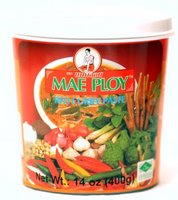
2. You are all natural. Reread that list of ingredients. There is not a chemical, preservative, or artificial ingredient in the bunch; just real, natural, flavorful ingredients. No added sugars or fats either.
3. You have authentic Thai flavors. You were born in Thailand and I understand that Thai people use you in their everyday cooking. If you’re good enough for the Thai, you’re good enough for me!
4. I love your container. Your colorful label is pleasantly appealing with its collage of exotic vegetables and spices. The curry paste is vacuum-sealed in a thick plastic bag and then placed inside a plastic container with a snap-tight lid, making you easy to use and easy to store.
5. You have a long shelf life. Such an intense flavorful ingredient is used only by the spoonful, so it may take me a while to use up a container. No problem. Unopened, you may be stored in a cupboard for years. Once opened, you last for many months in the refrigerator.
6. You are a great value. At only $2.09 for a 14 ounce container at an Asian grocery store (less than 15 cents an ounce), I cannot find a better flavor bargain anywhere.
7. You are versatile. You come in green, red and yellow curry pastes as well as Panang and Matsaman curry pastes.
8. You inspire me in the kitchen. At first I used you only in classic Thai recipes. But you are so good; I began to experiment with you in my regular everyday cooking. You’ve added exciting Thai flavors to many everyday dishes.
If you love Thai food, like I do, but think it is too complicated to prepare at home, get a container of Mae Ploy curry paste (start with green or red) and try some of these fast and simple recipes. You too will fall in love.
Two of these three recipes are Thai dishes while the third draws its inspiration from several corners of the globe. All of them are very flavorful and quick and easy to prepare, thanks to my new love, Mae Ploy curry paste.
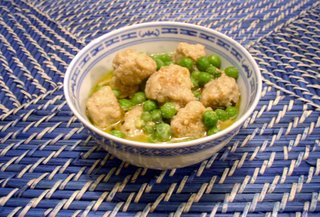
Green Curry Chicken Mince Balls with Peas
If I were Thai, this is the type of dish I imagine I would consider comfort food. And it takes less than 30 minutes from start to finish.
Adapted from a traditional Thai recipe
Yield 2 – 3 servings
1/2 lb ground chicken
2 – 3 tsp green curry paste
1 can coconut milk, chilled
1 tablespoon fish sauce
½ teaspoon salt
1 teaspoons sugar
1 cup frozen peas
fresh basil leaves, slivered
hot rice or rice noodles
Separate the thick coconut cream from the watery liquid. Put a medium sized pan on the heat, add the coconut cream and cook for 1 minute. Add the green curry paste and stir until mixed. Bring to the boil and simmer for several minutes.
Meanwhile, use a teaspoon to scoop small amounts of the ground chicken and gently roll into soft round balls about the size of grapes. They don’t have to be perfectly round, just roll them enough to hold together
Add the mince balls to the pan and cook for 10 minutes, stirring and tossing several times until the chicken is thoroughly cooked.
Add the coconut milk, fish sauce, salt, sugar, peas, and basil and stir it for a few minutes over the heat to warm them through.
Serve with hot rice or rice noodles.
Thai Shrimp and Spinach Curry
This is so quick to prepare and tastes just like restaurant fare. For variations, try different vegetables or use boneless chicken instead of shrimp.
Adapted from Gourmet magazine
Serves four.
14-ounce can unsweetened coconut milk, chilled
2 teaspoons Thai green or red curry paste
1 pound medium shrimp (about 24), shelled and deveined
2 tablespoons naam pla (Thai fish sauce)
2 carrots, sliced thin crosswise
1 red bell pepper, sliced thinly
1 bag of ready to use fresh spinach
3 tablespoons chopped fresh cilantro
cooked rice as an accompaniment
Spoon about 1/3 cup of the thick coconut cream from the top of the coconut milk and in a large heavy skillet cook the cream over moderate heat, stirring, for 2 to 3 minutes, or until it is thickened slightly.
Add the curry paste and cook the mixture, whisking, for 1 minute. Add the shrimp and sauté the mixture over moderately high heat, stirring, for 1 to 2 minutes, or until the shrimp turn pink.
Add the coconut milk and the naam pla and simmer the mixture, uncovered, stirring occasionally, for 1 minute, or until the shrimp are just cooked through. Transfer the shrimp with a slotted spoon to a bowl.
Add the carrots and the bell pepper to the skillet, and simmer the mixture for 5 minutes. Add the spinach in batches, stirring until each batch is wilted.
Return the shrimp to the skillet, and simmer the mixture, stirring occasionally, for 1 minute, until heated through. Sprinkle the dish with the cilantro and serve it with the rice.

Crunchy Thai Chicken Fingers
Adapted from a recipe by George Duran
Talk about fusion cuisine! The chicken finger concept is American, the flavors Thai, and the crunchy texture Japanese. These crispy oven-fried chicken strips have such zippy flavors from the curry paste no dipping sauce is necessary.
The next day the leftovers, although they lose their crispness, taste even better cold, making this perfect picnic fare.
1 /2 cup mayonnaise
1/2 tablespoon Thai curry paste (red or green)
2 large skinless, boneless chicken breasts (about 1 pound)
1 ½ cups panko (Japanese) bread crumbs
In a bowl, combine the mayonnaise and curry paste until well blended. Thin this with a little water, 1 tablespoon at a time, until you get the consistency of heavy cream.
Cut each chicken breast into 6 thick strips. Cutting on the diagonal will make more uniform strips. Drop the strips into the bowl of curry mayonnaise and stir to coat them well. Cover and refrigerate for an hour to two.
Heat the oven to 350 degrees F. Grease a non-stick baking sheet or cover a regular baking sheet with quick-release foil and grease that.
Pour the bread crumbs onto a plate. One by one, toss the chicken strips in the crumbs to completely cover them. Place them on the prepared baking sheet.
Bade for 15 to 20 minutes, or until the chicken is beginning brown on the bottom. Turn the strips and cook for an additional 15 minutes until golden and cooked through.
Tags: Mae Ploy curry paste, Thai recipes, chicken, shrimp
(with apologies to Elizabeth Barrett Browning)
It isn’t often that a purchased convenience food shortcut gets me excited but I’ve found Mae Ploy Curry Pastes from Thailand to be so kitchen friendly, flavorful, versatile, easy to use and inexpensive that I must extol their virtues. I’ll share a few recipes too, but first…..
Mae Ploy curry paste, how do I love thee? Let me count the ways.
1. You are an incredible time saver in the kitchen. Why just look at your ingredient list! Your Green Curry flavor, for example, contains green chili, lemon grass, garlic, salt, galangal, shrimp paste, kaffir lime peel, coriander seed, pepper, cumin, and turmeric. Even if I could find all those ingredients around here, there is no way I would slice, dice, chop, and pound, them to make my own curry paste when all of these special flavors can be so easily spooned from your charming container.

2. You are all natural. Reread that list of ingredients. There is not a chemical, preservative, or artificial ingredient in the bunch; just real, natural, flavorful ingredients. No added sugars or fats either.
3. You have authentic Thai flavors. You were born in Thailand and I understand that Thai people use you in their everyday cooking. If you’re good enough for the Thai, you’re good enough for me!
4. I love your container. Your colorful label is pleasantly appealing with its collage of exotic vegetables and spices. The curry paste is vacuum-sealed in a thick plastic bag and then placed inside a plastic container with a snap-tight lid, making you easy to use and easy to store.
5. You have a long shelf life. Such an intense flavorful ingredient is used only by the spoonful, so it may take me a while to use up a container. No problem. Unopened, you may be stored in a cupboard for years. Once opened, you last for many months in the refrigerator.
6. You are a great value. At only $2.09 for a 14 ounce container at an Asian grocery store (less than 15 cents an ounce), I cannot find a better flavor bargain anywhere.
7. You are versatile. You come in green, red and yellow curry pastes as well as Panang and Matsaman curry pastes.
8. You inspire me in the kitchen. At first I used you only in classic Thai recipes. But you are so good; I began to experiment with you in my regular everyday cooking. You’ve added exciting Thai flavors to many everyday dishes.
If you love Thai food, like I do, but think it is too complicated to prepare at home, get a container of Mae Ploy curry paste (start with green or red) and try some of these fast and simple recipes. You too will fall in love.
Two of these three recipes are Thai dishes while the third draws its inspiration from several corners of the globe. All of them are very flavorful and quick and easy to prepare, thanks to my new love, Mae Ploy curry paste.

Green Curry Chicken Mince Balls with Peas
If I were Thai, this is the type of dish I imagine I would consider comfort food. And it takes less than 30 minutes from start to finish.
Adapted from a traditional Thai recipe
Yield 2 – 3 servings
1/2 lb ground chicken
2 – 3 tsp green curry paste
1 can coconut milk, chilled
1 tablespoon fish sauce
½ teaspoon salt
1 teaspoons sugar
1 cup frozen peas
fresh basil leaves, slivered
hot rice or rice noodles
Separate the thick coconut cream from the watery liquid. Put a medium sized pan on the heat, add the coconut cream and cook for 1 minute. Add the green curry paste and stir until mixed. Bring to the boil and simmer for several minutes.
Meanwhile, use a teaspoon to scoop small amounts of the ground chicken and gently roll into soft round balls about the size of grapes. They don’t have to be perfectly round, just roll them enough to hold together
Add the mince balls to the pan and cook for 10 minutes, stirring and tossing several times until the chicken is thoroughly cooked.
Add the coconut milk, fish sauce, salt, sugar, peas, and basil and stir it for a few minutes over the heat to warm them through.
Serve with hot rice or rice noodles.
Thai Shrimp and Spinach Curry
This is so quick to prepare and tastes just like restaurant fare. For variations, try different vegetables or use boneless chicken instead of shrimp.
Adapted from Gourmet magazine
Serves four.
14-ounce can unsweetened coconut milk, chilled
2 teaspoons Thai green or red curry paste
1 pound medium shrimp (about 24), shelled and deveined
2 tablespoons naam pla (Thai fish sauce)
2 carrots, sliced thin crosswise
1 red bell pepper, sliced thinly
1 bag of ready to use fresh spinach
3 tablespoons chopped fresh cilantro
cooked rice as an accompaniment
Spoon about 1/3 cup of the thick coconut cream from the top of the coconut milk and in a large heavy skillet cook the cream over moderate heat, stirring, for 2 to 3 minutes, or until it is thickened slightly.
Add the curry paste and cook the mixture, whisking, for 1 minute. Add the shrimp and sauté the mixture over moderately high heat, stirring, for 1 to 2 minutes, or until the shrimp turn pink.
Add the coconut milk and the naam pla and simmer the mixture, uncovered, stirring occasionally, for 1 minute, or until the shrimp are just cooked through. Transfer the shrimp with a slotted spoon to a bowl.
Add the carrots and the bell pepper to the skillet, and simmer the mixture for 5 minutes. Add the spinach in batches, stirring until each batch is wilted.
Return the shrimp to the skillet, and simmer the mixture, stirring occasionally, for 1 minute, until heated through. Sprinkle the dish with the cilantro and serve it with the rice.

Crunchy Thai Chicken Fingers
Adapted from a recipe by George Duran
Talk about fusion cuisine! The chicken finger concept is American, the flavors Thai, and the crunchy texture Japanese. These crispy oven-fried chicken strips have such zippy flavors from the curry paste no dipping sauce is necessary.
The next day the leftovers, although they lose their crispness, taste even better cold, making this perfect picnic fare.
1 /2 cup mayonnaise
1/2 tablespoon Thai curry paste (red or green)
2 large skinless, boneless chicken breasts (about 1 pound)
1 ½ cups panko (Japanese) bread crumbs
In a bowl, combine the mayonnaise and curry paste until well blended. Thin this with a little water, 1 tablespoon at a time, until you get the consistency of heavy cream.
Cut each chicken breast into 6 thick strips. Cutting on the diagonal will make more uniform strips. Drop the strips into the bowl of curry mayonnaise and stir to coat them well. Cover and refrigerate for an hour to two.
Heat the oven to 350 degrees F. Grease a non-stick baking sheet or cover a regular baking sheet with quick-release foil and grease that.
Pour the bread crumbs onto a plate. One by one, toss the chicken strips in the crumbs to completely cover them. Place them on the prepared baking sheet.
Bade for 15 to 20 minutes, or until the chicken is beginning brown on the bottom. Turn the strips and cook for an additional 15 minutes until golden and cooked through.
Tags: Mae Ploy curry paste, Thai recipes, chicken, shrimp
Wednesday, December 06, 2006
Emilia-Romagna Food Souvenirs
I recently returned from a wonderful week in the Emilia-Romagna region of Italy where my holiday focused on the area’s gastronomy. That part of the country is truly Italy’s food heart and soul, as it is the birthplace of Parmigiano Reggiano, balsamic vinegar, prosciutto and many other Italian food specialties.
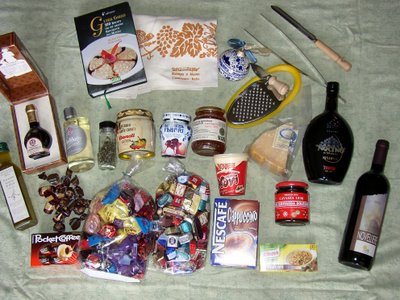
It was a great trip, loaded with cooking lessons, visits to makers of artisanal food products, great meals, and more, providing me with lots of interesting stories and recipes to post here. This first one is a round-up of the souvenirs I brought home. Of course they are all food-related.
Balsamic Vinegar
We visited Acetaia Malpighi in Modena, producers of fine balsamic vinegars, where we learned about the ancient process still used today to make this magical elixir and then enjoyed a tasting of different vinegars aged for 6, 12, 25, and 50 years. What amazing differences between them.
 I splurged on a bottle of 25 year old Aceto Balsamico Tradizionale, which is so good by itself it can be lapped from a spoon. The white balsamic vinegar is also very tasty. Much lighter, it is used like lemon juice, sprinkled over fish or even fruit.
I splurged on a bottle of 25 year old Aceto Balsamico Tradizionale, which is so good by itself it can be lapped from a spoon. The white balsamic vinegar is also very tasty. Much lighter, it is used like lemon juice, sprinkled over fish or even fruit.
They threw in a couple of handfuls of some interesting candies, too. The Vin Royal candy (“cioccolatini ripieni di Aceto Balsamico”), is a chocolate shell filled with balsamic vinegar, which makes quite an interesting combination. The Vin Drop candy (“caramella ripieni all’aceto balsamico”), a strawberry-flavored hard candy filled with the vinegar syrup was an even better combination.
Parmagiano Reggiano
I watched firsthand how this king of cheeses is made, from the raw milk to the aging, and then had an opportunity to taste. The entire process is quite detailed and labor-intensive, taking several years from cow to consumption, which explains why this cheese is so expensive. I shot many pictures so I’ll be posting them here in the near future.
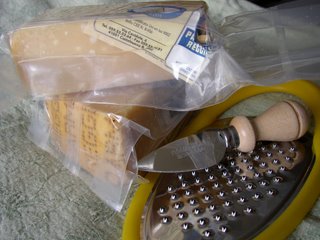
The casearia had an outlet shop where they sold their cheese and other dairy products and the shop was packed with locals, so I knew this was a good place to buy cheese. I purchased two shrink-wrapped chunks of the stagionato (aged 36 months) for only 13.40 a kilo, less than half the price of 24 month parmigiano back home.
Majani Candies
Majani, a fine chocolatier of Bologna, makes a wonderful array of chocolates. One of the most popular is the Fiat, layers of chocolate and hazelnut that just melts in your mouth. It comes in dark chocolate, too!
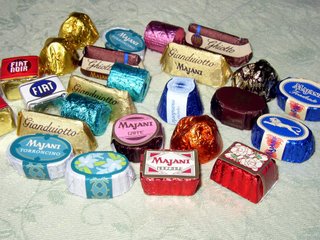
Pocket Coffee
I still don’t know why this Italian made candy has an English name. Although not a fine candy, this popular tidbit is very coveted because it is sold only in the cooler weather. Pure espresso syrup fills the chocolate casing. Two of these and you’ve had your caffeine for the day!
Amarena Fabbri
 Fabbri, a local manufacturer of fine fruit products, make this delicious cherry treat. The wild cherries in syrup are perfect for topping ice cream, swirling into yogurt or embellishing a slice of cheesecake or plain pound cake. The traditional blue and white patterned ceramic jar is pretty too.
Fabbri, a local manufacturer of fine fruit products, make this delicious cherry treat. The wild cherries in syrup are perfect for topping ice cream, swirling into yogurt or embellishing a slice of cheesecake or plain pound cake. The traditional blue and white patterned ceramic jar is pretty too.
Nocino Liqueur
Every place we dined, whether in a restaurant or at someone’s home, the standard after dinner cordial served was homemade Nocino, a dark digestive liqueur made from green walnuts. I had never had Nocino before, and the first sip revealed a mysterious blend of complex flavors evocative of jungle roots, sweet dark spices, and aromatic bitters. I really enjoyed it.

I obtained the personal recipe of one family but will have to wait until June to make it, when the green walnuts are ready. In the meantime I purchased a bottle of commercial Nocino to bring home. Unfortunately, I found the commercial version quite disappointing. It lacks the deep complexity of the homemade one and had an almost medicinal flavor. I’ll definitely be making my own.
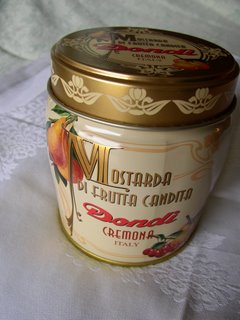 Mostarda di Cremona
Mostarda di Cremona
Italian mostardas are not like regular mustards but are chutney-like condiments made from candied fruits. This specialty from Cremona contains contains peaches, pears, apricots, tangerines, figs and cherries in a hot, spicy, tangy mustard syrup. It is traditionally served with Bollito Misto, a regional dish made from various boiled meats, but it also makes a great condiment on a cheese platter. I love this stuff! My taste buds tell me mostarda will be very complementary with smoked ham, so the next time I bake a ham I will be creating a relish made from this.
Crema Novi
 A hazelnut chocolate spread, like Nutella, but of much higher quality. Containing about 3 times the hazelnuts and almost twice the cocoa, Crema Novi is to Nutella what real gold is to pyrite. Another difference, Nutella adds hydrogenated oils to their product to make up for the paucity of nuts and cocoa. After tasting Crema Novi I can never eat Nutella again.
A hazelnut chocolate spread, like Nutella, but of much higher quality. Containing about 3 times the hazelnuts and almost twice the cocoa, Crema Novi is to Nutella what real gold is to pyrite. Another difference, Nutella adds hydrogenated oils to their product to make up for the paucity of nuts and cocoa. After tasting Crema Novi I can never eat Nutella again.
Crema Novi is nice on toast and great in crepes. I’ve even spread it on a soft flour tortilla and rolled it up for a tasty snack.
Porcini Mushroom bouillon cubes
 I don’t usually use bouillon cubes because they are so salty but when I saw these porcini mushroom cubes made by Knorr, I decided to try them. I think they may add great flavor to quick soups, sauces, and rice dishes. We’ll see if they become a future “must have” trinket from Italy.
I don’t usually use bouillon cubes because they are so salty but when I saw these porcini mushroom cubes made by Knorr, I decided to try them. I think they may add great flavor to quick soups, sauces, and rice dishes. We’ll see if they become a future “must have” trinket from Italy.
Mostarda Bolognese
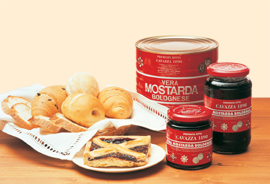 In one of our cooking lessons we filled ravioli cookies with this thick dark fruit spread. Made from apples, pears and oranges, this not-too-sweet spread, somewhat reminiscent of apple butter, is also great on toast and a fine addition to a cheese platter.
In one of our cooking lessons we filled ravioli cookies with this thick dark fruit spread. Made from apples, pears and oranges, this not-too-sweet spread, somewhat reminiscent of apple butter, is also great on toast and a fine addition to a cheese platter.
Cuneesi chocolates with liquor
They certainly don’t skimp on the liquor in these candies! They greet you with their booze-scented breath before you even unwrap one. The chocolate shell surrounds a soft truffle center that is flavored with Gran Marnier, whiskey, rum, Strega, or one of several other liquors.
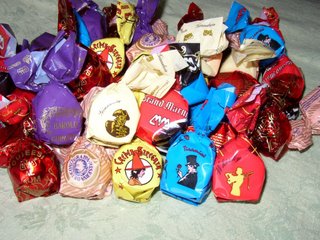
The best shops in Bologna to buy food souvenirs
I spent many hours exploring Bologna’s streets and shops and can recommend these two shops for their prices and selection. The fancy shops in the historic market district of Bologna are certainly worth visiting to admire their boutique-like beauty, but these two shops, just short walks from the Two Towers, are the places to make your purchases. Some items were half the price there.
Best Shop for food souvenirs and gifts:
Scaramagli
Strada Maggiore, 31
Bologna
Wines, liquers, groceries, candies, cookies and more
Best shop for candies :
Il Caffe Bazaar
Via Guerrazzi, 8
They also have a large selection of wines and liquor.
Tags: Emilia Romagna, Italy, food, souvenirs
I recently returned from a wonderful week in the Emilia-Romagna region of Italy where my holiday focused on the area’s gastronomy. That part of the country is truly Italy’s food heart and soul, as it is the birthplace of Parmigiano Reggiano, balsamic vinegar, prosciutto and many other Italian food specialties.

It was a great trip, loaded with cooking lessons, visits to makers of artisanal food products, great meals, and more, providing me with lots of interesting stories and recipes to post here. This first one is a round-up of the souvenirs I brought home. Of course they are all food-related.
Balsamic Vinegar
We visited Acetaia Malpighi in Modena, producers of fine balsamic vinegars, where we learned about the ancient process still used today to make this magical elixir and then enjoyed a tasting of different vinegars aged for 6, 12, 25, and 50 years. What amazing differences between them.
 I splurged on a bottle of 25 year old Aceto Balsamico Tradizionale, which is so good by itself it can be lapped from a spoon. The white balsamic vinegar is also very tasty. Much lighter, it is used like lemon juice, sprinkled over fish or even fruit.
I splurged on a bottle of 25 year old Aceto Balsamico Tradizionale, which is so good by itself it can be lapped from a spoon. The white balsamic vinegar is also very tasty. Much lighter, it is used like lemon juice, sprinkled over fish or even fruit.They threw in a couple of handfuls of some interesting candies, too. The Vin Royal candy (“cioccolatini ripieni di Aceto Balsamico”), is a chocolate shell filled with balsamic vinegar, which makes quite an interesting combination. The Vin Drop candy (“caramella ripieni all’aceto balsamico”), a strawberry-flavored hard candy filled with the vinegar syrup was an even better combination.
Parmagiano Reggiano
I watched firsthand how this king of cheeses is made, from the raw milk to the aging, and then had an opportunity to taste. The entire process is quite detailed and labor-intensive, taking several years from cow to consumption, which explains why this cheese is so expensive. I shot many pictures so I’ll be posting them here in the near future.

The casearia had an outlet shop where they sold their cheese and other dairy products and the shop was packed with locals, so I knew this was a good place to buy cheese. I purchased two shrink-wrapped chunks of the stagionato (aged 36 months) for only 13.40 a kilo, less than half the price of 24 month parmigiano back home.
Majani Candies
Majani, a fine chocolatier of Bologna, makes a wonderful array of chocolates. One of the most popular is the Fiat, layers of chocolate and hazelnut that just melts in your mouth. It comes in dark chocolate, too!

Pocket Coffee

I still don’t know why this Italian made candy has an English name. Although not a fine candy, this popular tidbit is very coveted because it is sold only in the cooler weather. Pure espresso syrup fills the chocolate casing. Two of these and you’ve had your caffeine for the day!
Amarena Fabbri
 Fabbri, a local manufacturer of fine fruit products, make this delicious cherry treat. The wild cherries in syrup are perfect for topping ice cream, swirling into yogurt or embellishing a slice of cheesecake or plain pound cake. The traditional blue and white patterned ceramic jar is pretty too.
Fabbri, a local manufacturer of fine fruit products, make this delicious cherry treat. The wild cherries in syrup are perfect for topping ice cream, swirling into yogurt or embellishing a slice of cheesecake or plain pound cake. The traditional blue and white patterned ceramic jar is pretty too.Nocino Liqueur
Every place we dined, whether in a restaurant or at someone’s home, the standard after dinner cordial served was homemade Nocino, a dark digestive liqueur made from green walnuts. I had never had Nocino before, and the first sip revealed a mysterious blend of complex flavors evocative of jungle roots, sweet dark spices, and aromatic bitters. I really enjoyed it.

I obtained the personal recipe of one family but will have to wait until June to make it, when the green walnuts are ready. In the meantime I purchased a bottle of commercial Nocino to bring home. Unfortunately, I found the commercial version quite disappointing. It lacks the deep complexity of the homemade one and had an almost medicinal flavor. I’ll definitely be making my own.
 Mostarda di Cremona
Mostarda di CremonaItalian mostardas are not like regular mustards but are chutney-like condiments made from candied fruits. This specialty from Cremona contains contains peaches, pears, apricots, tangerines, figs and cherries in a hot, spicy, tangy mustard syrup. It is traditionally served with Bollito Misto, a regional dish made from various boiled meats, but it also makes a great condiment on a cheese platter. I love this stuff! My taste buds tell me mostarda will be very complementary with smoked ham, so the next time I bake a ham I will be creating a relish made from this.
Crema Novi
 A hazelnut chocolate spread, like Nutella, but of much higher quality. Containing about 3 times the hazelnuts and almost twice the cocoa, Crema Novi is to Nutella what real gold is to pyrite. Another difference, Nutella adds hydrogenated oils to their product to make up for the paucity of nuts and cocoa. After tasting Crema Novi I can never eat Nutella again.
A hazelnut chocolate spread, like Nutella, but of much higher quality. Containing about 3 times the hazelnuts and almost twice the cocoa, Crema Novi is to Nutella what real gold is to pyrite. Another difference, Nutella adds hydrogenated oils to their product to make up for the paucity of nuts and cocoa. After tasting Crema Novi I can never eat Nutella again.Crema Novi is nice on toast and great in crepes. I’ve even spread it on a soft flour tortilla and rolled it up for a tasty snack.
Porcini Mushroom bouillon cubes
 I don’t usually use bouillon cubes because they are so salty but when I saw these porcini mushroom cubes made by Knorr, I decided to try them. I think they may add great flavor to quick soups, sauces, and rice dishes. We’ll see if they become a future “must have” trinket from Italy.
I don’t usually use bouillon cubes because they are so salty but when I saw these porcini mushroom cubes made by Knorr, I decided to try them. I think they may add great flavor to quick soups, sauces, and rice dishes. We’ll see if they become a future “must have” trinket from Italy.Mostarda Bolognese
 In one of our cooking lessons we filled ravioli cookies with this thick dark fruit spread. Made from apples, pears and oranges, this not-too-sweet spread, somewhat reminiscent of apple butter, is also great on toast and a fine addition to a cheese platter.
In one of our cooking lessons we filled ravioli cookies with this thick dark fruit spread. Made from apples, pears and oranges, this not-too-sweet spread, somewhat reminiscent of apple butter, is also great on toast and a fine addition to a cheese platter.Cuneesi chocolates with liquor
They certainly don’t skimp on the liquor in these candies! They greet you with their booze-scented breath before you even unwrap one. The chocolate shell surrounds a soft truffle center that is flavored with Gran Marnier, whiskey, rum, Strega, or one of several other liquors.

The best shops in Bologna to buy food souvenirs
I spent many hours exploring Bologna’s streets and shops and can recommend these two shops for their prices and selection. The fancy shops in the historic market district of Bologna are certainly worth visiting to admire their boutique-like beauty, but these two shops, just short walks from the Two Towers, are the places to make your purchases. Some items were half the price there.
Best Shop for food souvenirs and gifts:
Scaramagli
Strada Maggiore, 31
Bologna
Wines, liquers, groceries, candies, cookies and more
Best shop for candies :
Il Caffe Bazaar
Via Guerrazzi, 8
They also have a large selection of wines and liquor.
Tags: Emilia Romagna, Italy, food, souvenirs